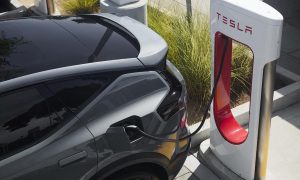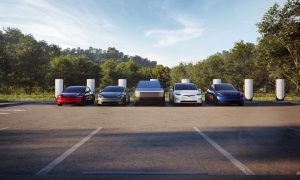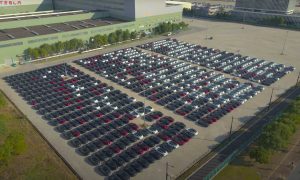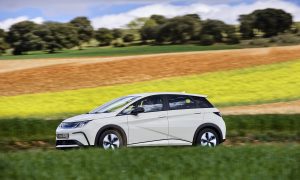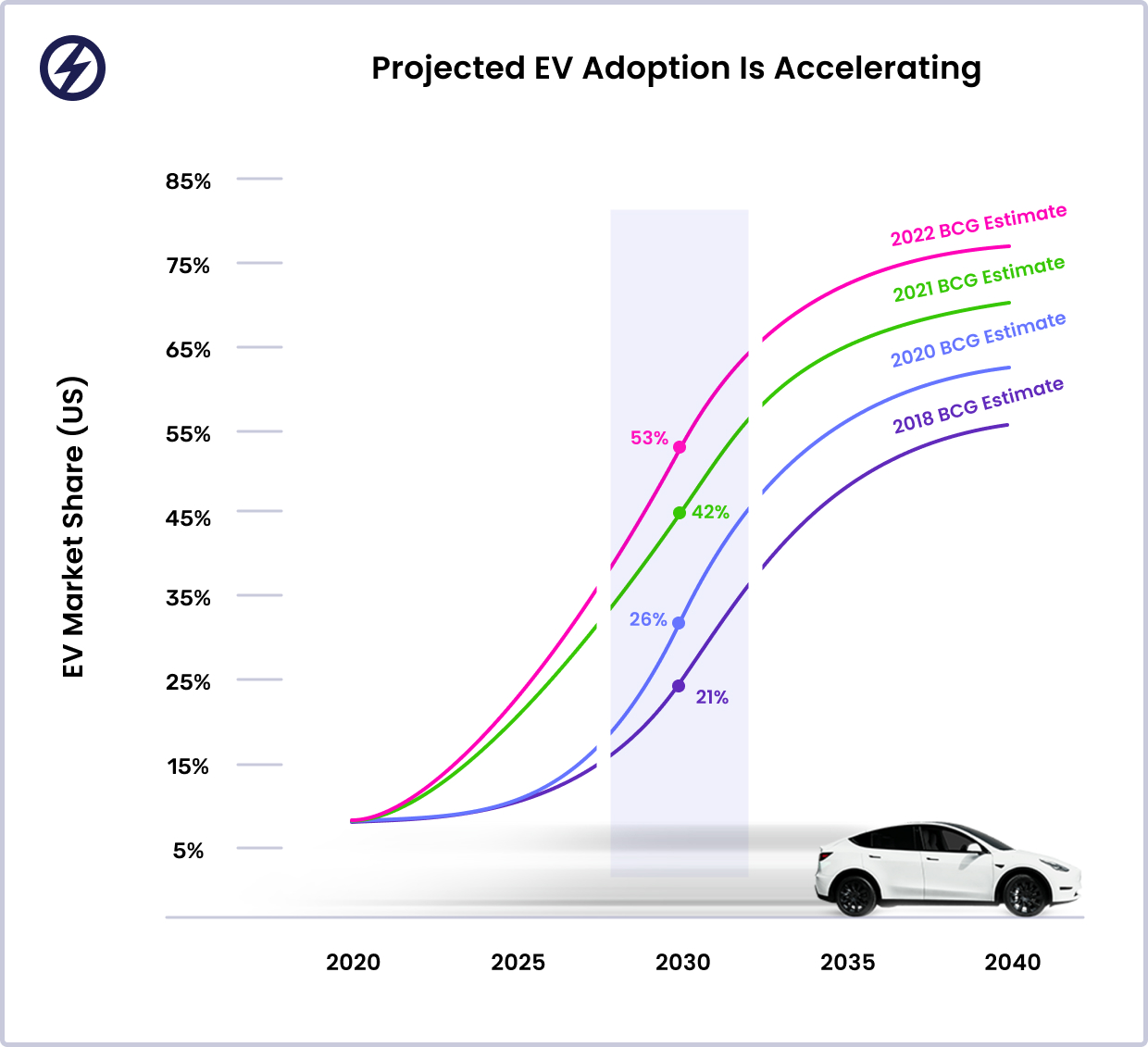

News
U.S. EV adoption is happening faster than anticipated
EV adoption in the U.S. happening much faster than anticipated, according to an observation of research by Recurrent Auto which is focused on providing transparency and confidence in pre-owned EV transactions. The research directly contradicts and challenges a statement by Jack Hollis, the executive vice president of sales at Toyota Motor North America.
According to Hollis, consumer demand isn’t sufficient enough for the mass adoption of battery electric vehicles to develop as fast as everyone would like. He added that battery electric vehicles cost too much and that the infrastructure isn’t ready for recharging the batteries away from home.
“I don’t think the market is ready. I don’t think the infrastructure is ready. And even if you were ready to purchase one, and if you could afford it … they’re still too high,” Hollis said.
Recurrent Auto: EV adoption is happening faster than expected
In an interview with Teslarati, Recurrent CEO, Scott Case shared an observation of a study by Boston Consulting Group (BCG) which has released a market projection for EV adoption annually since 2018.
Scott told me that Recurrent noticed that BCG repeated the same analysis four times since 2018 and has gotten it wrong each time.
“What we’ve seen every time they’ve done this is that they’ve just missed their forecast and gotten too low every single time.”
He said what was really interesting was that they were seeing BCG’s forecast and noticed that despite having all of the data and models, they’ve been “systematically under forecasting how fast the EV adoption is going to happen.”

The graph above shows how the EV sales projection for 2030 by BCG changed each time it released a report. According to BCG, EV sales projections in the U.S. for 2030 continued to grow to:
- 21% in the 2018 report
- 26% in the 2020 report
- 42% in the 2021 report
- 53% in the 2022 report
What Scott and the team at Recurrent found strange was that in the course of four years, the U.S. EV sales projections for 2030 more than doubled growing from an estimated 21% to 53%.
Scott pointed out that BCG isn’t the only company that has consistently missed how quickly the auto market is transitioning.
“The market adoption is just happening faster than any moment in the past. This is not about when we get to complete it, or what the numbers have been already. It’s what the best industry experts are forecasting about how fast this is going to happen.”
“We still have eight years between now and 2030. How many more times is this going to get forecasted? Eventually, they will get it right because we’ll be in 2030 and we’ll know exactly how many cars were sold that are EVs versus combustion engines. But there’s clearly only one direction that this adoption forecast is going.”
3 Major Factors
Scott went over the three major factors BCG uses in its model.
“First, it’s what are the projections for battery prices? This is a huge component of the cost of EVs. Second, is what the vehicle selection looks like and how many automakers are adopting different models. And the third is government policy changes. When you think about those three factors and over the course of the 2018-2022 models, you can sort of understand what’s been changing.”
Scott added that there was a 97% cost reduction in lithium-ion battery prices over the past three decades up to 2018.
“Since 2018, the decrease in cost flattened out, and even over the last year, it increased somewhat because of the supply chain difficulties and global issues. That’s not what was going on in this model. It’s not the battery price changes that are causing this forecast.”
“I think what you’re seeing over the course of this four-year period is the second factor. It’s vehicle selection and it translates into how many automakers are adopting and adding vehicles to their fleet. That’s a function of how automakers understand what consumers want to buy. I would say that this is a true reflection of market demand and not any government policy whether it’s a ban or a tax credit.”
Scott pointed out that next year, the Tesla Model Y will be the global best-selling vehicle without any help from any tax credit.
“You know what car it’s knocking off? It’s the Toyota Camry.”
One thing that BCG’s 2022 forecast did not include was the impacts of the Inflation Reduction Act which was signed just last month. Another thing not reflected in the 2022 forecast was California’s proposed ban on the sale of gasoline vehicles in 2034.
“California just passed the total ban on new ICE sales in 2035. Washington State where I live has–it’s nonbinding but it’s a 2030 cut-off. I’m not sure either of those is actually going to be needed because I think that the market going to take care of the transition well before those sales projections happen.”
“The most recent run of the BCG estimate was in the spring. They ran the model in the spring and published it in June. At that point, the Inflation Reduction Act was dead. Everyone thought the EV tax credit was dead and done. That doesn’t even reflect the impact of that. I would expect the next time that this model gets to run in 2023, you’ve got the impact of the EV tax credit which is a ten-year run, and the California gas car ban for 2035.”
He also said the bans will probably not be needed due to how fast the market is transitioning to EVs before they take effect. The forecast will most likely be even higher once they account for tax credits and the changing government policies.
“There’s room to grow here.”
Note: Johnna is a Tesla shareholder and supports its mission.
Your feedback is important. If you have any comments, concerns, or see a typo, you can email me at johnna@teslarati.com. You can also reach me on Twitter @JohnnaCrider1
Elon Musk
Tesla Supercharger Diner food menu gets a sneak peek as construction closes out
What are you ordering at the Tesla Diner?

The Tesla Supercharger Diner in Los Angeles is nearing completion as construction appears to be winding down significantly. However, the more minor details, such as what the company will serve at its 50s-style diner for food, are starting to be revealed.
Tesla’s Supercharger Diner is set to open soon, seven years after CEO Elon Musk first drafted the idea in a post on X in 2018. Musk has largely come through on most of what he envisioned for the project: the diner, the massive movie screens, and the intended vibe are all present, thanks to the aerial and ground footage shared on social media.
We already know the Diner will be open 24/7, based on decals placed on the front door of the restaurant that were shared earlier this week. We assume that Tesla Optimus will come into play for these long and uninterrupted hours.
The Tesla Diner is basically finished—here’s what it looks like
As far as the food, Tesla does have an email also printed on the front door of the Diner, but we did not receive any response back (yet) about what cuisine it will be offering. We figured it would be nothing fancy and it would be typical diner staples: burgers, fries, wings, milkshakes, etc.
According to pictures taken by @Tesla_lighting_, which were shared by Not a Tesla App, the food will be just that: quick and affordable meals that diners do well. It’s nothing crazy, just typical staples you’d find at any diner, just with a Tesla twist:
Tesla Diner food:
• Burgers
• Fries
• Chicken Wings
• Hot Dogs
• Hand-spun milkshakes
• And more https://t.co/kzFf20YZQq pic.twitter.com/aRv02TzouY— Sawyer Merritt (@SawyerMerritt) July 17, 2025
As the food menu is finalized, we will be sure to share any details Tesla provides, including a full list of what will be served and its prices.
Additionally, the entire property appears to be nearing its final construction stages, and it seems it may even be nearing completion. The movie screens are already up and showing videos of things like SpaceX launches.
There are many cars already using the Superchargers at the restaurant, and employees inside the facility look to be putting the finishing touches on the interior.
🚨 Boots on the ground at the Tesla Diner:
— TESLARATI (@Teslarati) July 17, 2025
It’s almost reminiscent of a Tesla version of a Buc-ee’s, a southern staple convenience store that offers much more than a traditional gas station. Of course, Tesla’s version is futuristic and more catered to the company’s image, but the idea is the same.
It’s a one-stop shop for anything you’d need to recharge as a Tesla owner. Los Angeles building permits have not yet revealed the date for the restaurant’s initial operation, but Tesla may have its eye on a target date that will likely be announced during next week’s Earnings Call.
News
Tesla’s longer Model Y did not scale back requests for this vehicle type from fans
Tesla fans are happy with the new Model Y, but they’re still vocal about the need for something else.

Tesla launched a slightly longer version of the Model Y all-electric crossover in China, and with it being extremely likely that the vehicle will make its way to other markets, including the United States, fans are still looking for something more.
The new Model Y L in China boasts a slightly larger wheelbase than its original version, giving slightly more interior room with a sixth seat, thanks to a third row.
Tesla exec hints at useful and potentially killer Model Y L feature
Tesla has said throughout the past year that it would focus on developing its affordable, compact models, which were set to begin production in the first half of the year. The company has not indicated whether it met that timeline or not, but many are hoping to see unveilings of those designs potentially during the Q3 earnings call.
However, the modifications to the Model Y, which have not yet been officially announced for any markets outside of China, still don’t seem to be what owners and fans are looking forward to. Instead, they are hoping for something larger.
A few months ago, I reported on the overall consensus within the Tesla community that the company needs a full-size SUV, minivan, or even a cargo van that would be ideal for camping or business use.
Tesla is missing one type of vehicle in its lineup and fans want it fast
That mentality still seems very present amongst fans and owners, who state that a full-size SUV with enough seating for a larger family, more capability in terms of cargo space for camping or business operation, and something to compete with gas cars like the Chevrolet Tahoe, Ford Expedition, or electric ones like the Volkswagen ID.BUZZ.
We asked the question on X, and Tesla fans were nearly unanimously in support of a larger SUV or minivan-type vehicle for the company’s lineup:
🚨 More and more people are *still* saying that, despite this new, longer Model Y, Tesla still needs a true three-row SUV
Do you agree? https://t.co/QmbRDcCE08 pic.twitter.com/p6m5zB4sDZ
— TESLARATI (@Teslarati) July 16, 2025
Here’s what some of the respondents said:
100% agree, we need a larger vehicle.
Our model Y is quickly getting too small for our family of 5 as the kids grow. A slightly longer Y with an extra seat is nice but it’s not enough if you’re looking to take it on road trips/vacations/ kids sports gear etc.
Unfortunately we…
— Anthony Hunter (@_LiarsDice_) July 17, 2025
Had to buy a Kia Carnival Hybrid because Tesla doesn’t have a true 3 row vehicle with proper space and respectable range. pic.twitter.com/pzwFyHU8Gi
— Neil, like the astronaut (@Neileeyo) July 17, 2025
Agreed! I’m not sure who created this but I liked it enough to save it. pic.twitter.com/Sof5nMehjS
— 🦉Wise Words of Wisdom – Inspirational Quotes (IQ) (@WiseWordsIQ) July 16, 2025
Tesla is certainly aware that many of its owners would like the company to develop something larger that competes with the large SUVs on the market.
However, it has not stated that anything like that is in the current plans for future vehicles, as it has made a concerted effort to develop Robotaxi alongside the affordable, compact models that it claims are in development.
It has already unveiled the Robovan, a people-mover that can seat up to 20 passengers in a lounge-like interior.
The Robovan will be completely driverless, so it’s unlikely we will see it before the release of a fully autonomous Full Self-Driving suite from Tesla.
Energy
Tesla launches first Virtual Power Plant in UK – get paid to use solar
Tesla has launched its first-ever Virtual Power Plant program in the United Kingdom.

Tesla has launched its first-ever Virtual Power Plant program in the United Kingdom. This feature enables users of solar panels and energy storage systems to sell their excess energy back to the grid.
Tesla is utilizing Octopus Energy, a British renewable energy company that operates in multiple markets, including the UK, France, Germany, Italy, Spain, Australia, Japan, New Zealand, and the United States, as the provider for the VPP launch in the region.
The company states that those who enroll in the program can earn up to £300 per month.
Tesla has operated several VPP programs worldwide, most notably in California, Texas, Connecticut, and the U.S. territory of Puerto Rico. This is not the first time Tesla has operated a VPP outside the United States, as there are programs in Australia, Japan, and New Zealand.
This is its first in the UK:
Our first VPP in the UK
You can get paid to share your energy – store excess energy in your Powerwall & sell it back to the grid
You’re making £££ and the community is powered by clean energy
Win-win pic.twitter.com/evhMtJpgy1
— Tesla UK (@tesla_uk) July 17, 2025
Tesla is not the only company that is working with Octopus Energy in the UK for the VPP, as it joins SolarEdge, GivEnergy, and Enphase as other companies that utilize the Octopus platform for their project operations.
It has been six years since Tesla launched its first VPP, as it started its first in Australia back in 2019. In 2024, Tesla paid out over $10 million to those participating in the program.
Participating in the VPP program that Tesla offers not only provides enrolled individuals with the opportunity to earn money, but it also contributes to grid stabilization by supporting local energy grids.
-

 Elon Musk1 day ago
Elon Musk1 day agoWaymo responds to Tesla’s Robotaxi expansion in Austin with bold statement
-

 News1 day ago
News1 day agoTesla exec hints at useful and potentially killer Model Y L feature
-

 Elon Musk2 days ago
Elon Musk2 days agoElon Musk reveals SpaceX’s target for Starship’s 10th launch
-

 Elon Musk3 days ago
Elon Musk3 days agoTesla ups Robotaxi fare price to another comical figure with service area expansion
-

 News1 day ago
News1 day agoTesla’s longer Model Y did not scale back requests for this vehicle type from fans
-

 News1 day ago
News1 day ago“Worthy of respect:” Six-seat Model Y L acknowledged by Tesla China’s biggest rivals
-

 News2 days ago
News2 days agoFirst glimpse of Tesla Model Y with six seats and extended wheelbase
-

 Elon Musk2 days ago
Elon Musk2 days agoElon Musk confirms Tesla is already rolling out a new feature for in-car Grok


